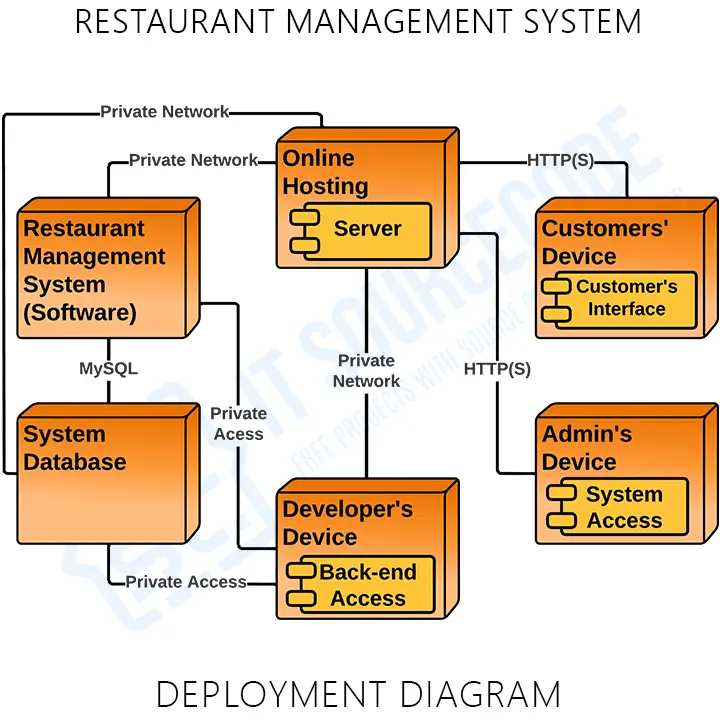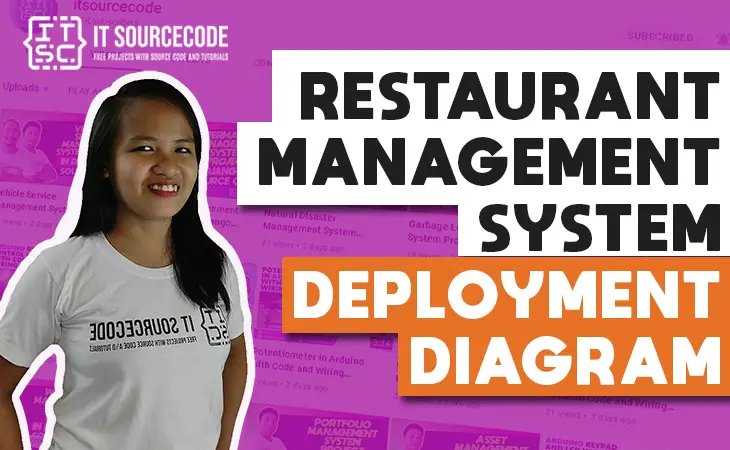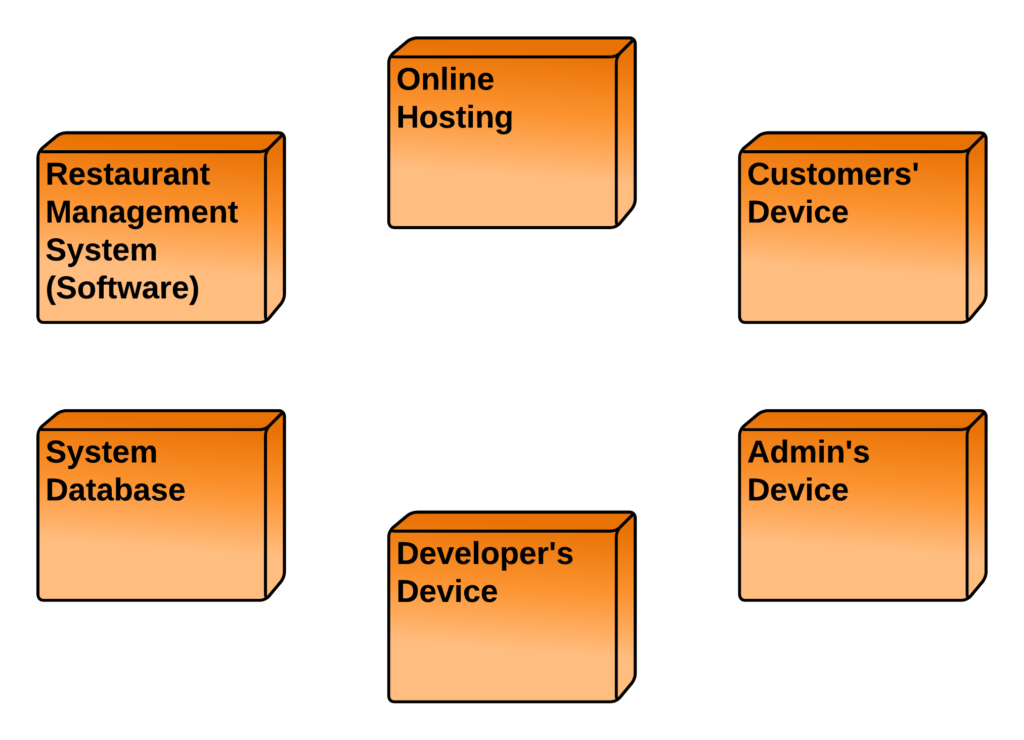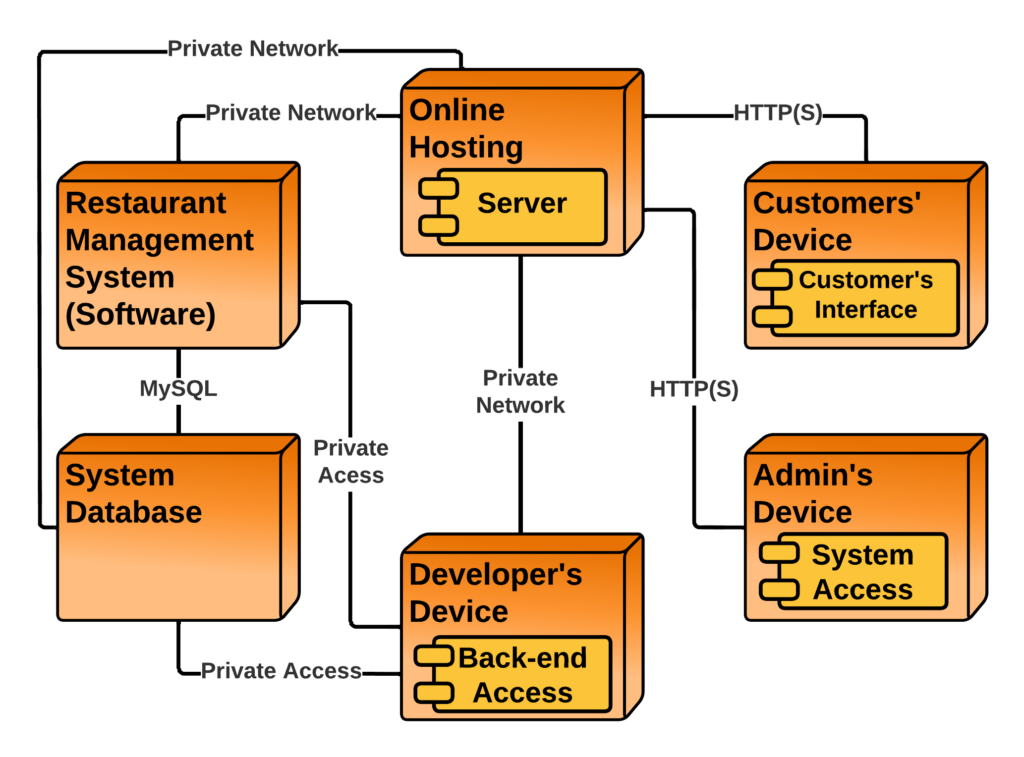What is Restaurant Management System Deployment Diagram?
A deployment diagram for restaurant management system is used to describe the system’s operation showing the hardware and software components that run in each node, and explaining the connections between them.
Restaurant Management System Deployment Diagram: Table of contents
- What is Restaurant Management System Deployment Diagram?
- Deployment Diagram for Restaurant Management System: Content
- Restaurant Management System Description
- Deployment Diagram for Restaurant Management System
- Restaurant Management System UML Deployment Diagram (Explanation)
- Deployment Diagram for Restaurant Management System (PDF)
- UML Deployment Diagram for Restaurant Management System
- Benefits of Designing Deployment Diagram:
- Steps in Developing Restaurant Management System Deployment Diagram
- Conclusion:
- Recommended Articles from the Author:
- Inquiries
Deployment Diagram for Restaurant Management System: Content
The table shows the basic details of the deployment diagram of the restaurant management system. It has quick description details of the project.
| Name: | Restaurant Management System Deployment Diagram |
| Abstract: | The Restaurant Management Deployment Diagram represents the physical structure of the project. It reveals the software and hardware included for the application to work correctly. |
| UML Diagram: | Deployment Diagram |
| Users: | Restaurant Admin, Crews, and Customers. |
| Tools Used: | Diagraming Tools that have UML Deployment Diagram Symbols |
| Designer: | ITSourceCode.com |
Restaurant Management System Description
Restaurant management software aims to simplify some of the most common management duties in the restaurant industry. For example, it can combine information from different online booking channels so you can see all reservations and keep this information up to date to avoid double bookings.
This restaurant management system refers to all software that aids in the efficiency of foodservice operations. Restaurants, bars, bakeries, cafes, cloud (dark, virtual, ghost) kitchens, food trucks, and delivery services are all examples.
It performs a variety of duties that are required for a restaurant to function. It’s a catch-all word for various restaurant management tools and techniques that ensure top-notch customer service. The following items can be included in your RMS: Point-of-sale Orders and payments are entered into the system.
Deployment Diagram for Restaurant Management System
The nodes included in restaurant management system deployment diagram are represented by boxes. These boxes are labeled as software or hardware that specifies the included components to carry out the restaurant management process. The boxes will then be connected and labeled to declare the type of connection they have with the other components.

Restaurant Management Systems assist businesses in organizing their operations so that they may concentrate on growing their businesses. The system will manage menu items and inventories, keep track of food costs, and provide restaurant owners and managers with a clear picture at any given time.
Restaurant Management System UML Deployment Diagram (Explanation)
The Restaurant Management System UML deployment diagram explains the sketch of the relationship between software and hardware. These hardware and software are labeled to clarify their part in the system’s operation. They were represented by nodes and the connections were represented by labeled arrows.
The deployment diagram shows the scenario when the system is deployed. It has 6 nodes represented with boxes and relationship connections. The nodes are the restaurant management system, the customer’s device, the admin’s device, the system database, online hosting (system server), and the developer’s device. The online hosting (server) node will host the developed system and database that will be accessed by the users online.
For the connection, the system and the database are connected to the server (online hosting) using a private network which enables it to pass the data and information to the devices and enable users to access the system and database. The developer will have the back-end access which will only be utilized when there are errors or when the system needs an update.
Deployment Diagram for Restaurant Management System (PDF)
You may download the Deployment Diagram PDF by clicking the button below. It has the full details and discussion on System’s Deployment Diagram. You can also modify its content to complete your project requirements and needs.
UML Deployment Diagram for Restaurant Management System
A deployment diagram for restaurant system in UML is used to illustrate its’ physical architecture. In UML, deployment diagrams can show you how the software and hardware of the learning system work together and where the processing takes place.
The restaurant management system uses a UML deployment diagram to show how should the developed software be deployed. It clarifies the communications between links(nodes) which helps the project to work according to the design given to it. Deployment diagrams depict the setup of run-time processing nodes and the components that reside on them.
Benefits of Designing Deployment Diagram:
- It aids in the visualization of the various aspects involved.
- Helps in the better description of all the hardware components used by software components.
- For better understanding, it assists in defining the involved runtime processing nodes.
- This diagram depicts the software installation process on the hardware component.
- It shows how a piece of software interacts with hardware to carry out its tasks.
Steps in Developing Restaurant Management System Deployment Diagram
Time needed: 10 minutes
Here are the steps in developing the restaurant management system deployment diagram.
- Determine the diagram’s purpose.
To determine the purpose of the deployment diagram, know the description of the restaurant management system. The purpose of the deployment diagram is to design the needed components (software and hardware) of the system. This is to support and imply the whole processes when the restaurant management system operates.
- Add the diagram’s nodes.
The term “node” refers to the physical devices that make up the system. Artifacts are deployed on these nodes. Node instances on which artifact instances will be implemented are also possible.

The essential software or hardware elements, or nodes, in the system are represented by the three-dimensional boxes known as nodes. The smaller forms included within the boxes reflect the software artifacts that are distributed, and the lines from node to node indicate relationships. - Add more pieces to the diagram, such as components or artifacts, if needed.
A deployment diagram depicts the locations of components and artifacts in the deployed system. In a software system, artifacts are model elements that reflect physical entities. Executable files, libraries, software components, documents, and databases are examples of physical implementation units.

- Add communication associations.
A communication association (path) is a sort of relationship between nodes in a deployment diagram that indicates how they communicate messages and signals in UML modeling. Deploy relationships in UML show that a certain type of node can be used to deploy a certain type of artifact.

A message or other sort of communication between nodes is indicated by a line called a relation or association.
Additional Knowledge
The topology of the physical components of a system, where the software components are installed, is visualized using deployment diagrams. Deployment diagrams are used to depict a system’s static deployment view. Nodes and their relationships are depicted in deployment diagrams.
The Deployment Model shows how components will be distributed across the system architecture in detail. It contains information about network capabilities, server specifications, hardware requirements, and other aspects of the planned system’s deployment.
Conclusion:
You need to know the diagrams used to design and develop the Restaurant Management System. That is because you cannot perfectly create a fully-functional system without it. But if you create this deployment diagram, you will know the software and hardware components that the project should possess. Not only that, you will find out the needed specifications and connect them to the other UML Diagrams.
The deployment diagram is used to model the system’s physical architecture. It describes the connections of components between software and hardware system. By completing the Diagrams per module or per process, you will easily achieve your desired system. Check out our Related and Recommended Articles for more Learning and Information.
Related Articles:
- Deployment Diagram for Online Shopping System
- Deployment Diagram for Hospital Management System
- Deployment Diagram for Railway Reservation System
- Deployment Diagram for E-commerce Website
- Deployment Diagram for ATM System
Recommended Articles from the Author:
- Restaurant Management System Dataflow Diagram
- Restaurant Management System UML Activity Diagram
- Restaurant Management System UML Diagrams
- Restaurant Management System Class Diagram
- Restaurant Management System Sequence Diagram
Inquiries
If you have inquiries or suggestions about Deployment Diagram for Restaurant Management System, just leave us your comments below. We would be glad to hear to concerns and suggestions and be part of your learning.
Keep us updated and Good day!




